Frequently asked questions - Company
1. What services does Grey Theta Information Security offer?
We provide a wide range of cybersecurity services, including Offensive Security (Penetration Testing, Red Teaming), Defensive Security (SOC, Incident Response), GRC & Compliance (ISO 27001, GDPR), and Security Consultancy (On-demand Experts, vCISO).
2. What industries do you serve?
We work with startups, SMEs, and enterprises across various sectors, including finance, healthcare, e-commerce, and cloud-based platforms.
3. What makes Grey Theta different from other cybersecurity providers?
Our team consists of real-time experts, bug bounty hunters, and hall of famers with over 10 years of hands-on experience. We combine affordable pricing with high-quality services to help businesses enhance their security posture.
4. What is PTaaS (Penetration Testing as a Service)?
PTaaS is a continuous, subscription-based penetration testing service. It allows organizations to test their applications and infrastructure throughout the year instead of relying on periodic assessments.
5. How can Red Teaming help our organization?
Red Teaming simulates real-world attack scenarios to identify weaknesses in your defenses. It helps assess how effectively your security teams can detect and respond to sophisticated threats.
6. How do you handle sensitive data during testing?
At Grey Theta, we follow strict protocols and non-disclosure agreements (NDAs) to ensure the confidentiality of client data. All findings and reports are securely delivered and stored with restricted access.
7. What is your approach to GRC and compliance support?
We assist organizations in developing policies, managing risks, and achieving compliance with standards such as ISO 27001, GDPR, and HIPAA. Our GRC services include BC/DR planning, vendor risk management, and policy framework development.
8. Do you offer Security Consultancy services?
Yes, we provide on-demand security experts, vCISO services, and project-based consultants to meet your unique requirements. Whether you need a SOC analyst, incident responder, or CISO, we can deploy them quickly to support your business.
9. Do you offer training programs for employees?
Yes, we conduct security awareness and training programs to help employees understand common threats and best practices for mitigating risks. Our training includes phishing simulations, incident response exercises, and more.
10. How soon can Grey Theta respond to an urgent request?
We understand the critical nature of cybersecurity, so we strive to respond within 24 hours to urgent requests and incidents. For consultancy services, we offer rapid deployment of professionals as per your business needs.
11. How do you price your services?
We offer flexible pricing models based on the scope of the project and service duration. For recurring services like PTaaS, we provide subscription-based packages to ensure cost efficiency.
12. How can I get started with Grey Theta?
Simply contact us through our website or email to discuss your requirements. Our team will assess your needs and recommend the most suitable services to strengthen your security posture.
13. How much does it cost?
Our pricing varies primarily based on three key factors: scope, complexity, and type of assessment, along with a few additional considerations. We offer flexible options to fit your specific needs and budget. Please contact us to discuss your requirements, and we’ll provide a tailored quote that ensures the best value for your business.
1. What is vulnerability scanning, and why is it important?
Vulnerability scanning is a process that identifies and evaluates potential weaknesses in your systems and applications. It is important because it helps organizations proactively address security flaws before they can be exploited by attackers, reducing the risk of data breaches.
2. How often should we conduct security audits?
Security audits should be conducted regularly—typically annually or biannually—to ensure that your security policies and practices remain effective. However, they should also be performed after significant changes to your IT infrastructure or in response to emerging threats.
3. What is an incident response plan, and why do we need one?
An incident response plan outlines the steps to take when a security incident occurs. It is essential for minimizing the impact of a breach, ensuring a swift and organized response, and restoring normal operations as quickly as possible.
4. What are tabletop exercises, and how do they help our organization?
Tabletop exercises are simulated scenarios where team members practice their response to a security incident. They help identify gaps in your incident response plan, improve coordination among team members, and enhance overall preparedness for real-world situations.
5. What is a Security Operations Center (SoC)?
A Security Operations Center (SoC) is a centralized unit that monitors, detects, and responds to security threats in real-time. It provides ongoing surveillance of your IT environment, helping to ensure rapid detection and mitigation of security incidents.
6. How can we benefit from an IT risk and gap analysis?
An IT risk and gap analysis assesses your current security posture, identifying vulnerabilities and areas for improvement. This information is critical for prioritizing security investments and enhancing your overall security strategy.
7. What support do you provide for compliance requirements?
We offer compliance support by helping your organization understand relevant regulations and industry standards, conducting audits, and implementing necessary changes to meet compliance requirements such as GDPR, HIPAA, and ISO 27001.
8. What does a security strategy entail?
A security strategy is a comprehensive plan that outlines your organization’s approach to protecting its assets and data. It includes risk assessments, security policies, and measures to mitigate risks, ensuring that security aligns with your business objectives.
9. How often should we update our security road map?
Your security road map should be updated regularly, ideally on an annual basis, or whenever significant changes occur within your organization or the threat landscape. Continuous evaluation helps ensure that your security measures remain effective and relevant.
10. Why are training and awareness programs necessary?
Training and awareness programs are vital for educating employees about security best practices and potential threats. A well-informed workforce is your first line of defense against social engineering attacks and other security risks, significantly reducing the likelihood of human error leading to a security breach.
FAQ - Defensive Security
Grey Theta ™
Information Security pvt ltd
Reg office
82/3 Ballem Vari Street, Ramavarappadu, Krishna, Vijayawada (rural),
Andhra Pradesh, India,
521108.
contact@greytheta.com
+91 9133633328
© 2025. All rights reserved.
Company
Services
Resources
Contact
Legal
Blog
Privacy Policy
Terms of Service
Cookie Policy


GRC
Security consultancy






